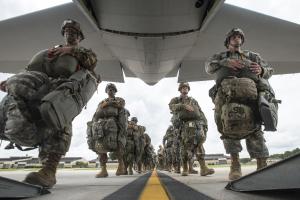By Rachael Parsons, MPH
June 24, 2019
 U.S. Air Force photo by Master Sgt. Brian Ferguson
U.S. Air Force photo by Master Sgt. Brian Ferguson
Combat and military operations are inherently stressful. Service members train hard to prepare mentally and physically for deployment, but they cannot completely avoid the stressors associated with serving. Be it lack of sleep, physical stress, exposure to extreme environmental conditions, or bearing witness to potentially traumatic events, service members will face a wide array of combat and operational stressors. As one might expect, these experiences can be very impactful, resulting in a broad spectrum of reactions. Some reactions can be useful for safety in a combat zone but may not translate to life outside of deployment. So how do we determine which responses to combat and operational stress are adaptive and normal, and which might warrant care intervention?
Combat and operational stress reactions (COSRs) are psychobiological reactions that may stem from combat stressors, such as personal injury, witnessing death or killing of combatants, or operational stressors, such as long work hours in extreme temperatures, dangerous work conditions, or non-combat related injuries. COSRs present as a range of signs and symptoms, including fatigue, sleep problems, decreased attention, hypervigilance, social withdrawal, and anxiety, among other reactions.
Because COSRs are expected in response to combat and military operations, each of the military services spends many hours training for just these kinds of events in order to increase confidence and skills and decrease the impact of combat and operational stress. In doing so, they aim to enhance combat readiness and improve service members' ability to manage these events. These types of programs are referred to as combat and operational stress control (COSC). The overarching objectives of COSC programs are to prevent, identify, and manage COSRs in combat and operational settings.
Because COSRs are considered a normal response, experiencing COSRs does not indicate a mental health disorder, like posttraumatic stress disorder (PTSD), or any other diagnosable condition. COSRs and PTSD may share common signs and symptoms, but the differences between the two affect how service members experiencing COSRs and those diagnosed with PTSD are managed and treated.
For COSRs, consider these suggestions:
-
Encourage service members to connect with peers and talk about their experience. These connections can be one of the most beneficial self-management strategies, fostering unit cohesion and social support.
-
Promote a healthy lifestyle, including good sleep hygiene, nutrition, and physical training.
-
Activities such as tactical breathing, meditation, or yoga may help with relaxation.
-
Encourage service members to steer away from unhealthy coping strategies, such as heavy drinking or substance use.
-
Reassure service members that COSRs are common and within their ability to handle.
-
If COSRs don't resolve over time or symptoms are significant (indicating that they are more than COSR), a referral to a mental health provider is indicated.
COSRs can be distressing, so along with informing service members of the self-management strategies discussed above, make sure they know where to go if they ever need a helping hand.
For stress reduction techniques in high-stress operations, visit the Real Warriors website.
Ms. Parsons is a public health analyst at the Psychological Health Center of Excellence. She has a Master of Public Health degree and supports the Psychological Health Promotion Branch.